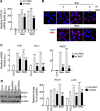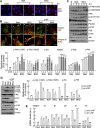Oxidative stress generated by polycyclic aromatic hydrocarbons from ambient particulate matter enhance vascular smooth muscle cell migration through MMP upregulation and actin reorganization
- PMID: 35449013
- PMCID: PMC9026692
- DOI: 10.1186/s12989-022-00472-z
Oxidative stress generated by polycyclic aromatic hydrocarbons from ambient particulate matter enhance vascular smooth muscle cell migration through MMP upregulation and actin reorganization
Abstract
Background: Epidemiological studies have suggested that elevated concentrations of particulate matter (PM) are strongly associated with the incidence of atherosclerosis, however, the underlying cellular and molecular mechanisms of atherosclerosis by PM exposure and the components that are mainly responsible for this adverse effect remain to be established. In this investigation, we evaluated the effects of ambient PM on vascular smooth muscle cell (VSMC) behavior. Furthermore, the effects of polycyclic aromatic hydrocarbons (PAHs), major components of PM, on VSMC migration and the underlying mechanisms were examined.
Results: VSMC migration was significantly increased by treatment with organic matters extracted from ambient PM. The total amount of PAHs contained in WPM was higher than that in SPM, leading to higher ROS generation and VSMC migration. The increased migration was successfully inhibited by treatment with the anti-oxidant, N-acetyl-cysteine (NAC). The levels of matrix metalloproteinase (MMP) 2 and 9 were significantly increased in ambient PM-treated VSMCs, with MMP9 levels being significantly higher in WPM-treated VSMCs than in those treated with SPM. As expected, migration was significantly increased in all tested PAHs (anthracene, ANT; benz(a)anthracene, BaA) and their oxygenated derivatives (9,10-Anthraquinone, AQ; 7,12-benz(a)anthraquinone, BAQ, respectively). The phosphorylated levels of focal adhesion kinase (FAK) and formation of the focal adhesion complex were significantly increased in ambient PM or PAH-treated VSMCs, and these effects were blocked by administration of NAC or α-NF, an inhibitor of AhR, the receptor that allows PAH uptake. Subsequently, the levels of phosphorylated Src and NRF, the downstream targets of FAK, were altered with a pattern similar to that of p-FAK.
Conclusions: PAHs, including oxy-PAHs, in ambient PM may have dual effects that lead to an increase in VSMC migration. One is the generation of oxidative stress followed by MMP upregulation, and the other is actin reorganization that results from the activation of the focal adhesion complex.
Keywords: Ambient particulate matter; Matrix metalloproteinase; Migration; Oxidative stress; Polycyclic aromatic hydrocarbons; Vascular smooth muscle cells.
© 2022. The Author(s).
Conflict of interest statement
The authors declare that they have no competing interests.
Figures






Similar articles
-
Oxygenated polycyclic aromatic hydrocarbons from ambient particulate matter induce electrophysiological instability in cardiomyocytes.Part Fibre Toxicol. 2020 Jun 11;17(1):25. doi: 10.1186/s12989-020-00351-5. Part Fibre Toxicol. 2020. PMID: 32527278 Free PMC article.
-
Aryl hydrocarbon receptor activation-mediated vascular toxicity of ambient fine particulate matter: contribution of polycyclic aromatic hydrocarbons and osteopontin as a biomarker.Part Fibre Toxicol. 2022 Jun 23;19(1):43. doi: 10.1186/s12989-022-00482-x. Part Fibre Toxicol. 2022. PMID: 35739584 Free PMC article.
-
Genotoxicity and DNA damage signaling in response to complex mixtures of PAHs in biomass burning particulate matter from cashew nut roasting.Environ Pollut. 2020 Jan;256:113381. doi: 10.1016/j.envpol.2019.113381. Epub 2019 Oct 15. Environ Pollut. 2020. PMID: 31662259
-
Exposure to Atmospheric Particulate Matter-Bound Polycyclic Aromatic Hydrocarbons and Their Health Effects: A Review.Int J Environ Res Public Health. 2021 Feb 23;18(4):2177. doi: 10.3390/ijerph18042177. Int J Environ Res Public Health. 2021. PMID: 33672189 Free PMC article. Review.
-
Children environmental exposure to particulate matter and polycyclic aromatic hydrocarbons and biomonitoring in school environments: A review on indoor and outdoor exposure levels, major sources and health impacts.Environ Int. 2019 Mar;124:180-204. doi: 10.1016/j.envint.2018.12.052. Epub 2019 Jan 14. Environ Int. 2019. PMID: 30654326 Review.
Cited by
-
Burn pit-related smoke causes developmental and behavioral toxicity in zebrafish: Influence of material type and emissions chemistry.Heliyon. 2024 Apr 14;10(8):e29675. doi: 10.1016/j.heliyon.2024.e29675. eCollection 2024 Apr 30. Heliyon. 2024. PMID: 38681659 Free PMC article.
-
The role of oxidative stress in aortic dissection: a potential therapeutic target.Front Cardiovasc Med. 2024 Jul 12;11:1410477. doi: 10.3389/fcvm.2024.1410477. eCollection 2024. Front Cardiovasc Med. 2024. PMID: 39070552 Free PMC article. Review.
-
Impact of Canadian Wildfire-Emitted Particulate Matter on THP-1 Lung Macrophage Health and Function.Environ Sci Technol. 2025 Mar 4;59(8):3869-3883. doi: 10.1021/acs.est.4c10304. Epub 2025 Feb 17. Environ Sci Technol. 2025. PMID: 39962934 Free PMC article.
-
Long-term ambient air pollution exposure and renal function and biomarkers of renal disease.Environ Health. 2024 Aug 9;23(1):67. doi: 10.1186/s12940-024-01108-9. Environ Health. 2024. PMID: 39123230 Free PMC article.
-
Vascular smooth muscle cell phenotypic switching in atherosclerosis.Heliyon. 2024 Sep 10;10(18):e37727. doi: 10.1016/j.heliyon.2024.e37727. eCollection 2024 Sep 30. Heliyon. 2024. PMID: 39309965 Free PMC article. Review.
References
-
- Jilani MH, Simon-Friedt B, Yahya T, Khan AY, Hassan SZ, Kash B, et al. Associations between particulate matter air pollution, presence and progression of subclinical coronary and carotid atherosclerosis: a systematic review. Atherosclerosis. 2020;306:22–32. doi: 10.1016/j.atherosclerosis.2020.06.018. - DOI - PubMed
Publication types
MeSH terms
Substances
LinkOut - more resources
Full Text Sources
Medical
Research Materials
Miscellaneous

